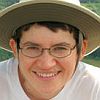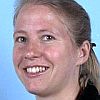| |
 
Olivier Gauthier and
François-Joseph Lapointe. Hybrids and Phylogenetics Revisited: A Statistical Test of Hybridization Using Quartets. In Systematic Botany, Vol. 32(1):8-15, 2007.
Keywords: explicit network, from quartets, hybridization, phylogenetic network, phylogeny, reconstruction, reticulogram, split decomposition.
Note: http://dx.doi.org/10.1600/036364407780360238.
Toggle abstract
"The occurrence of reticulations in the evolutionary history of species poses serious challenges for all modern practitioners of phylogenetic analysis. Such events, including hybridization, introgression, and lateral gene transfer, lead to evolutionary histories that cannot be adequately represented in the form of phylogenetic trees. Although numerous methods that allow for the reconstruction of phylogenetic networks have been proposed in recent years, the detection of reticulations still remains problematic. In this paper we present a Hybrid Detection Criterion (HDC) along with a statistical procedure that allows for the identification of hybrid taxa. The test assesses whether a putative hybrid is consistently intermediate between its postulated parents, with respect to the other taxa. The performance of the statistical method is evaluated using known hybrids of the genus Aphelandra (Acanthaceae) using two network methods: reticulograms and split decomposition graphs. Our results indicate that the HDC test is reliable when used jointly with split decomposition. On the other hand, the test lacks power and provides misleading results when using reticulograms. We then show how the procedure can be used as a tool to identify putative hybrids. © Copyright 2007 by the American Society of Plant Taxonomists."
|
|
| |
   
Stefan Grünewald,
Kristoffer Forslund,
Andreas W. M. Dress and
Vincent Moulton. QNet: An agglomerative method for the construction of phylogenetic networks from weighted quartets. In MBE, Vol. 24(2):532-538, 2007.
Keywords: abstract network, circular split system, from quartets, phylogenetic network, phylogeny, Program QNet, reconstruction, software.
Note: http://mbe.oxfordjournals.org/cgi/content/abstract/24/2/532.
Toggle abstract
"We present QNet, a method for constructing split networks from weighted quartet trees. QNet can be viewed as a quartet analogue of the distance-based Neighbor-Net (NNet) method for network construction. Just as NNet, QNet works by agglomeratively computing a collection of circular weighted splits of the taxa set which is subsequently represented by a planar split network. To illustrate the applicability of QNet, we apply it to a previously published Salmonella data set. We conclude that QNet can provide a useful alternative to NNet if distance data are not available or a character-based approach is preferred. Moreover, it can be used as an aid for determining when a quartet-based tree-building method may or may not be appropriate for a given data set. QNet is freely available for download. © The Author 2006. Published by Oxford University Press on behalf of the Society for Molecular Biology and Evolution. All rights reserved."
|
|
| |
  
Stefan Grünewald,
Vincent Moulton and
Andreas Spillner. Consistency of the QNet algorithm for generating planar split networks from weighted quartets. In DAM, Vol. 157(10):2325-2334, 2009.
Keywords: abstract network, consistency, from quartets, phylogenetic network, phylogeny, Program QNet, reconstruction, software.
Note: http://dx.doi.org/10.1016/j.dam.2008.06.038.
Toggle abstract
"Phylogenetic networks are a generalization of evolutionary or phylogenetic trees that allow the representation of conflicting signals or alternative evolutionary histories in a single diagram. Recently the Quartet-Net or "QNet" method was introduced, a method for computing a special kind of phylogenetic network called a split network from a collection of weighted quartet trees (i.e. phylogenetic trees with 4 leaves). This can be viewed as a quartet analogue of the distance-based Neighbor-Net (NNet) method for constructing outer-labeled planar split networks. In this paper, we prove that QNet is a consistent method, that is, we prove that if QNet is applied to a collection of weighted quartets arising from a circular split weight function, then it will return precisely this function. This key property of QNet not only ensures that it is guaranteed to produce a tree if the input corresponds to a tree, and an outer-labeled planar split network if the input corresponds to such a network, but also provides the main guiding principle for the design of the method. © 2008 Elsevier B.V. All rights reserved."
|
|
| |
    
Stefan Grünewald,
Katharina Huber,
Vincent Moulton,
Charles Semple and
Andreas Spillner. Characterizing weak compatibility in terms of weighted quartets. In Advances in Applied Mathematics, Vol. 42(3):329-341, 2009.
Keywords: abstract network, characterization, from quartets, split network, weak hierarchy.
Note: http://www.math.canterbury.ac.nz/~c.semple/papers/GHMSS08.pdf, slides at http://www.lirmm.fr/miep08/slides/12_02_huber.pdf.
|
|
| |

Stephen J. Willson. CSD Homomorphisms Between Phylogenetic Networks. In TCBB, Vol. 9(4), 2012.
Keywords: explicit network, from network, from quartets, phylogenetic network.
Note: http://www.public.iastate.edu/~swillson/Relationships11IEEE.pdf, preliminary version entitled Relationships Among Phylogenetic Networks.
Toggle abstract
"Since Darwin, species trees have been used as a simplified description of the relationships which summarize the complicated network N of reality. Recent evidence of hybridization and lateral gene transfer, however, suggest that there are situations where trees are inadequate. Consequently it is important to determine properties that characterize networks closely related to N and possibly more complicated than trees but lacking the full complexity of N. A connected surjective digraph map (CSD) is a map f from one network N to another network M such that every arc is either collapsed to a single vertex or is taken to an arc, such that f is surjective, and such that the inverse image of a vertex is always connected. CSD maps are shown to behave well under composition. It is proved that if there is a CSD map from N to M, then there is a way to lift an undirected version of M into N, often with added resolution. A CSD map from N to M puts strong constraints on N. In general, it may be useful to study classes of networks such that, for any N, there exists a CSD map from N to some standard member of that class. © 2012 IEEE."
|
|
| |
    
Changiz Eslahchi,
Reza Hassanzadeh,
Ehsan Mottaghi,
Mahnaz Habibi,
Hamid Pezeshk and
Mehdi Sadeghi. Constructing circular phylogenetic networks from weighted quartets using simulated annealing. In MBIO, Vol. 235(2):123-127, 2012.
Keywords: abstract network, from quartets, heuristic, phylogenetic network, phylogeny, Program SAQ-Net, Program SplitsTree, reconstruction, simulated annealing, software, split network.
Note: http://dx.doi.org/10.1016/j.mbs.2011.11.003.
Toggle abstract
"In this paper, we present a heuristic algorithm based on the simulated annealing, SAQ-Net, as a method for constructing phylogenetic networks from weighted quartets. Similar to QNet algorithm, SAQ-Net constructs a collection of circular weighted splits of the taxa set. This collection is represented by a split network. In order to show that SAQ-Net performs better than QNet, we apply these algorithm to both the simulated and actual data sets containing salmonella, Bees, Primates and Rubber data sets. Then we draw phylogenetic networks corresponding to outputs of these algorithms using SplitsTree4 and compare the results. We find that SAQ-Net produces a better circular ordering and phylogenetic networks than QNet in most cases. SAQ-Net has been implemented in Matlab and is available for download at http://bioinf.cs.ipm.ac.ir/softwares/saq.net. © 2011 Elsevier Inc."
|
|
| |
  
Philippe Gambette,
Vincent Berry and
Christophe Paul. Quartets and Unrooted Phylogenetic Networks. In JBCB, Vol. 10(4):1250004, 2012.
Keywords: abstract network, circular split system, explicit network, from quartets, level k phylogenetic network, orientation, phylogenetic network, phylogeny, polynomial, reconstruction, split, split network.
Note: http://hal.archives-ouvertes.fr/hal-00678046/en/.
Toggle abstract
"Phylogenetic networks were introduced to describe evolution in the presence of exchanges of genetic material between coexisting species or individuals. Split networks in particular were introduced as a special kind of abstract network to visualize conflicts between phylogenetic trees which may correspond to such exchanges. More recently, methods were designed to reconstruct explicit phylogenetic networks (whose vertices can be interpreted as biological events) from triplet data. In this article, we link abstract and explicit networks through their combinatorial properties, by introducing the unrooted analog of level-k networks. In particular, we give an equivalence theorem between circular split systems and unrooted level-1 networks. We also show how to adapt to quartets some existing results on triplets, in order to reconstruct unrooted level-k phylogenetic networks. These results give an interesting perspective on the combinatorics of phylogenetic networks and also raise algorithmic and combinatorial questions. © 2012 Imperial College Press."
|
|
| |
    
Stefan Grünewald,
Andreas Spillner,
Sarah Bastkowski,
Anja Bögershausen and
Vincent Moulton. SuperQ: Computing Supernetworks from Quartets. In TCBB, Vol. 10(1):151-160, 2013.
Keywords: abstract network, circular split system, from quartets, heuristic, phylogenetic network, phylogeny, Program QNet, Program SplitsTree, Program SuperQ, software, split network.
Toggle abstract
"Supertrees are a commonly used tool in phylogenetics to summarize collections of partial phylogenetic trees. As a generalization of supertrees, phylogenetic supernetworks allow, in addition, the visual representation of conflict between the trees that is not possible to observe with a single tree. Here, we introduce SuperQ, a new method for constructing such supernetworks (SuperQ is freely available at >www.uea.ac.uk/computing/superq.). It works by first breaking the input trees into quartet trees, and then stitching these together to form a special kind of phylogenetic network, called a split network. This stitching process is performed using an adaptation of the QNet method for split network reconstruction employing a novel approach to use the branch lengths from the input trees to estimate the branch lengths in the resulting network. Compared with previous supernetwork methods, SuperQ has the advantage of producing a planar network. We compare the performance of SuperQ to the Z-closure and Q-imputation supernetwork methods, and also present an analysis of some published data sets as an illustration of its applicability. © 2004-2012 IEEE."
|
|
| |
  
Fenglou Mao,
David Williams,
Olga Zhaxybayeva,
Maria S. Poptsova,
Pascal Lapierre,
J. Peter Gogarten and
Ying Xu. Quartet decomposition server: a platform for analyzing phylogenetic trees. In BMCB, Vol. 13:123, 2012.
Keywords: abstract network, from quartets, phylogenetic network, phylogeny, Program Quartet Decomposition, reconstruction, software, split network.
Toggle abstract
"Background: The frequent exchange of genetic material among prokaryotes means that extracting a majority or plurality phylogenetic signal from many gene families, and the identification of gene families that are in significant conflict with the plurality signal is a frequent task in comparative genomics, and especially in phylogenomic analyses. Decomposition of gene trees into embedded quartets (unrooted trees each with four taxa) is a convenient and statistically powerful technique to address this challenging problem. This approach was shown to be useful in several studies of completely sequenced microbial genomes.Results: We present here a web server that takes a collection of gene phylogenies, decomposes them into quartets, generates a Quartet Spectrum, and draws a split network. Users are also provided with various data download options for further analyses. Each gene phylogeny is to be represented by an assessment of phylogenetic information content, such as sets of trees reconstructed from bootstrap replicates or sampled from a posterior distribution. The Quartet Decomposition server is accessible at http://quartets.uga.edu.Conclusions: The Quartet Decomposition server presented here provides a convenient means to perform Quartet Decomposition analyses and will empower users to find statistically supported phylogenetic conflicts. © 2012 Mao et al.; licensee BioMed Central Ltd."
|
|
| |
 
Jialiang Yang,
Stefan Grünewald and
Xiu-Feng Wan. Quartet-Net: A Quartet Based Method to Reconstruct Phylogenetic Networks. In MBE, Vol. 30(5):1206-1217, 2013.
Keywords: from quartets, phylogenetic network, phylogeny, Program QuartetNet, reconstruction.
Toggle abstract
"Phylogenetic networks can model reticulate evolutionary events such as hybridization, recombination, and horizontal gene transfer. However, reconstructing such networks is not trivial. Popular character-based methods are computationally inefficient, whereas distance-based methods cannot guarantee reconstruction accuracy because pairwise genetic distances only reflect partial information about a reticulate phylogeny. To balance accuracy and computational efficiency, here we introduce a quartet-based method to construct a phylogenetic network from a multiple sequence alignment. Unlike distances that only reflect the relationship between a pair of taxa, quartets contain information on the relationships among four taxa; these quartets provide adequate capacity to infer a more accurate phylogenetic network. In applications to simulated and biological data sets, we demonstrate that this novel method is robust and effective in reconstructing reticulate evolutionary events and it has the potential to infer more accurate phylogenetic distances than other conventional phylogenetic network construction methods such as Neighbor-Joining, Neighbor-Net, and Split Decomposition. This method can be used in constructing phylogenetic networks from simple evolutionary events involving a few reticulate events to complex evolutionary histories involving a large number of reticulate events. A software called Quartet-Net is implemented and available at http://sysbio.cvm.msstate.edu/QuartetNet/. © 2013 The Author."
|
|
| |
|
| |
 
Jialiang Yang,
Stefan Grünewald,
Yifei Xu and
Xiu-Feng Wan. Quartet-based methods to reconstruct phylogenetic networks. In BMC Systems Biology, Vol. 80(21), 2014.
Keywords: abstract network, from quartets, phylogenetic network, phylogeny, Program QuartetMethods, Program QuartetNet, Program SplitsTree, reconstruction.
Note: http://dx.doi.org/10.1186/1752-0509-8-21
.
Toggle abstract
"Background: Phylogenetic networks are employed to visualize evolutionary relationships among a group of nucleotide sequences, genes or species when reticulate events like hybridization, recombination, reassortant and horizontal gene transfer are believed to be involved. In comparison to traditional distance-based methods, quartet-based methods consider more information in the reconstruction process and thus have the potential to be more accurate.Results: We introduce QuartetSuite, which includes a set of new quartet-based methods, namely QuartetS, QuartetA, and QuartetM, to reconstruct phylogenetic networks from nucleotide sequences. We tested their performances and compared them with other popular methods on two simulated nucleotide sequence data sets: one generated from a tree topology and the other from a complicated evolutionary history containing three reticulate events. We further validated these methods to two real data sets: a bacterial data set consisting of seven concatenated genes of 36 bacterial species and an influenza data set related to recently emerging H7N9 low pathogenic avian influenza viruses in China.Conclusion: QuartetS, QuartetA, and QuartetM have the potential to accurately reconstruct evolutionary scenarios from simple branching trees to complicated networks containing many reticulate events. These methods could provide insights into the understanding of complicated biological evolutionary processes such as bacterial taxonomy and reassortant of influenza viruses. © 2014 Yang et al.; licensee BioMed Central Ltd."
|
|
| |
|
|
|
 - forked on GitHub.
- forked on GitHub.






























